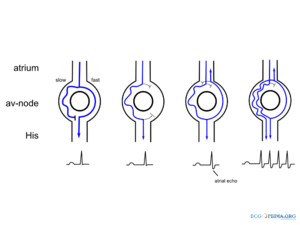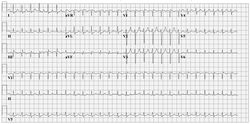AVNRT: Difference between revisions
mNo edit summary |
No edit summary |
||
| Line 13: | Line 13: | ||
}} | }} | ||
[[File:Re_entry.png|thumb|left|[[Re-entry]] as seen in AVNRT]] | [[File:Re_entry.png|thumb|left|[[Re-entry]] as seen in AVNRT]] | ||
'''AV Nodal Re-entry Tachycardia (AVNRT)''' or Atrial-Ventricular Nodal Re-entry Tachycardia is a [[SVT|supra-ventricular arrhythmia]]. It is, more precisely, a nodal arrhythmia. AVNRT is the most frequently occurring form of regular tachycardia. More females than males have signs of AVNRT. The ratio is approximately 3:1. Often patients present themselves with a fast-paced heart rate (they say their heart is racing). An AVNRT can be reversed by vagal stimulation (squat, massage of the Carotid sinuses), medication (adenosine, verapamil), or electrocardioversion. An AVNRT is a regular rhythm with a rate of 180-250 /min. An AVNRT appears to have a [[re-entry]] with a circuit in and around the AV node. A condition for AVNRT to occur is that 2 electric pathways occur in and around the AV node (a slow paced and a fast paced pathway). That gives way to the ccurrence of re-entry. | '''AV Nodal Re-entry Tachycardia (AVNRT)''' or Atrial-Ventricular Nodal Re-entry Tachycardia is a [[SVT|supra-ventricular arrhythmia]]. It is, more precisely, a nodal arrhythmia. AVNRT is the most frequently occurring form of regular tachycardia. More females than males have signs of AVNRT. The ratio is approximately 3:1. Often patients present themselves with a fast-paced heart rate (they say their heart is racing). An AVNRT can be reversed by vagal stimulation (squat, massage of the Carotid sinuses), medication (adenosine, verapamil, diltiazem), or electrocardioversion. An AVNRT is a regular rhythm with a rate of 180-250 /min. An AVNRT appears to have a [[re-entry]] with a circuit in and around the AV node. A condition for AVNRT to occur is that 2 electric pathways occur in and around the AV node (a slow paced and a fast paced pathway). That gives way to the ccurrence of re-entry. | ||
Two forms of ANVRT occur: typical and atypical ANVRT | Two forms of ANVRT occur: typical and atypical ANVRT | ||
Revision as of 22:33, 24 June 2011
| This is part of: Supraventricular Rhythms |

AV Nodal Re-entry Tachycardia (AVNRT) or Atrial-Ventricular Nodal Re-entry Tachycardia is a supra-ventricular arrhythmia. It is, more precisely, a nodal arrhythmia. AVNRT is the most frequently occurring form of regular tachycardia. More females than males have signs of AVNRT. The ratio is approximately 3:1. Often patients present themselves with a fast-paced heart rate (they say their heart is racing). An AVNRT can be reversed by vagal stimulation (squat, massage of the Carotid sinuses), medication (adenosine, verapamil, diltiazem), or electrocardioversion. An AVNRT is a regular rhythm with a rate of 180-250 /min. An AVNRT appears to have a re-entry with a circuit in and around the AV node. A condition for AVNRT to occur is that 2 electric pathways occur in and around the AV node (a slow paced and a fast paced pathway). That gives way to the ccurrence of re-entry.
Two forms of ANVRT occur: typical and atypical ANVRT
- Typical ANVRT (also described as common ANVRT or slow-fast ANVRT): The impulse travels over the slow pathway towards the ventricles and returns via the fast pathway to the atria. The retrograde P wave (or Atrial echo) shows up at the end of the QRS. 90 % of all patients with ANVRT are diagnosed with typical ANVRT.
- Atypical ANVRT (also described as uncommon ANVRT or fast-slow ANVRT): The impulse travels via the fast pathway towards the ventricles and returns via the slow pathway to the atria. The retrograde P wave appears far behind the QRS. Only about 6% of all ANVRT patients are diagnosed with atypical ANVRT.
8The remaining cases of ANVRT patients are diagnosed with a form of ANVRT that is even more rare. This form of ANVRT is slow/slow ANVRT (The impulse follows a complex route through the AV node and the surrounding area). Only 4 % of all patients diagnosed with ANVRT have slow/slow ANVRT.
How does an ANVRT show up on an ECG?
AVNRT is characterised by a smaller second R-wave (R’). This second R-wave looks similar to a Right Bundle Branch Block, but the QRS is < 120ms. The RP distance is < 100ms: the distance between the R-wave and the P-top is below 100ms. An AV Nodal Re-entry Tachycardia (AVNRT) is a rapid tachycardia with a typical rate around 200 bpm. The tachycardia origin is the AV node. A prerequisite for AVNRT is a slow and fast pathway in the AV node, most often caused by degradation of the AV nodular tissue. The dual pathways facilitate re-entry.
Two sensitive characteristics to identify AVNRT on the ECG are:
- R'. This is a small secondary R wave. It resembles a right bundle branch block, but the QRS width stays < 120ms.
- RP << 100ms. The distance between the R and P waves is less than 100ms.


